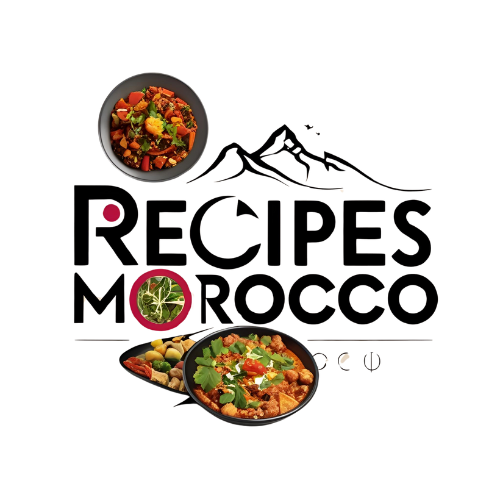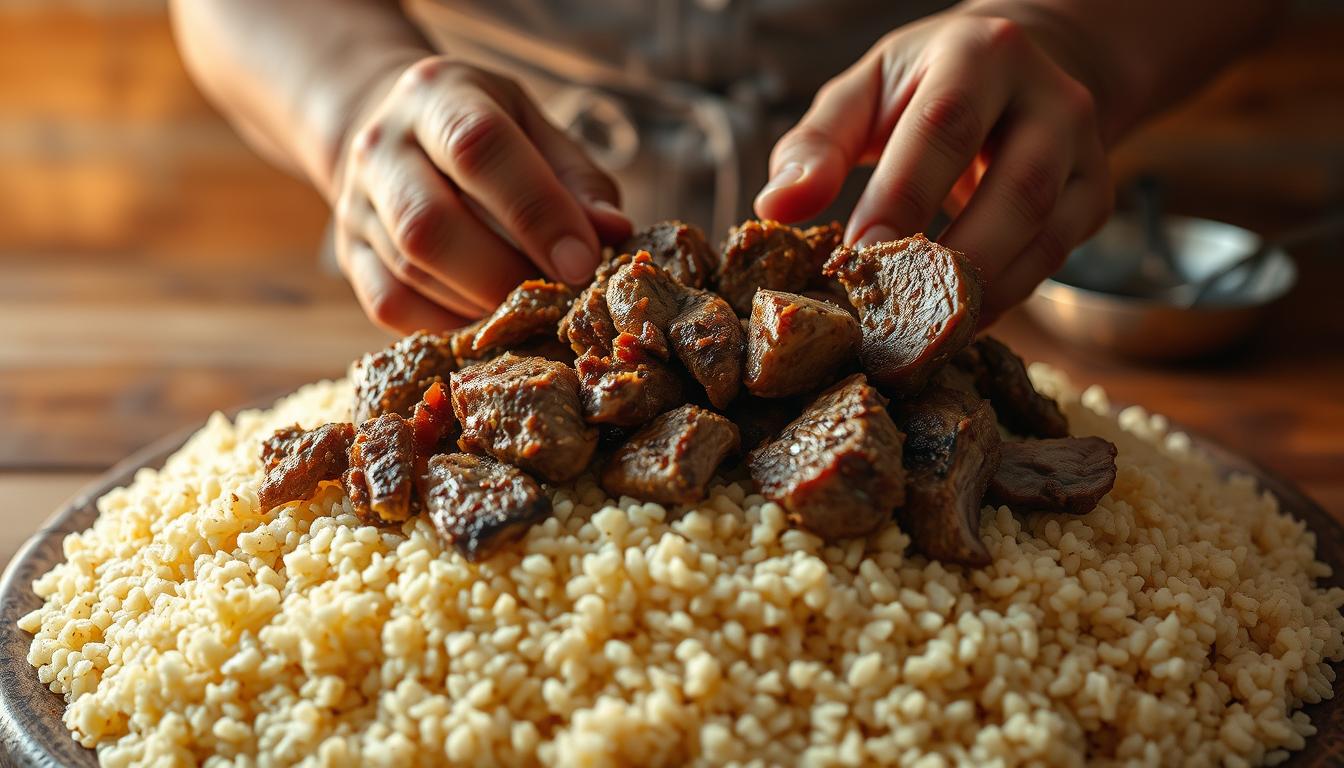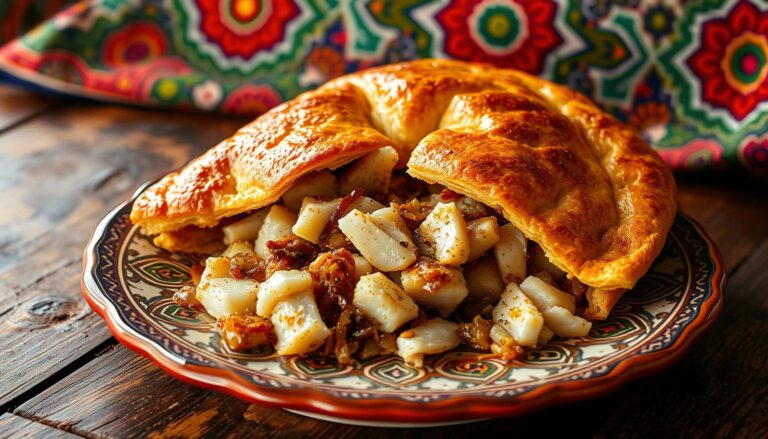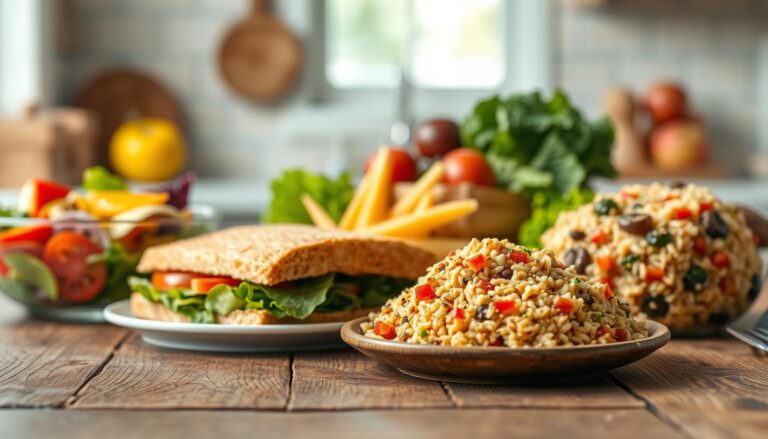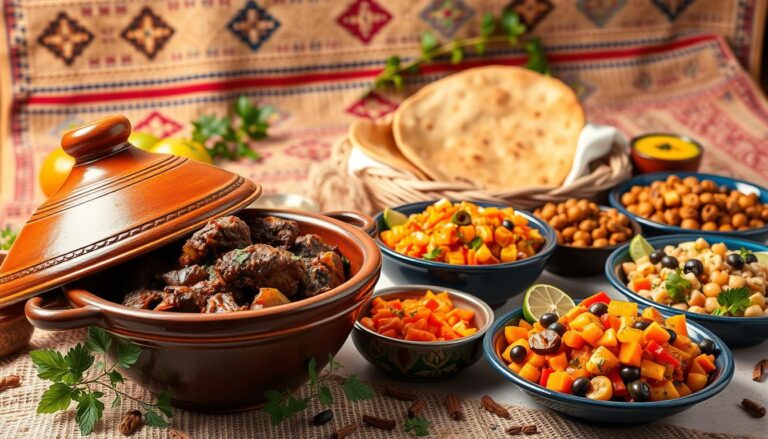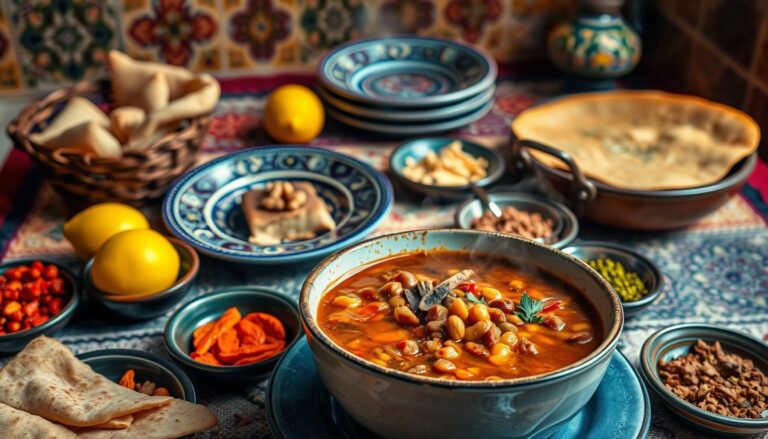Couscous with meat head
Discover the rich flavors of North Africa with couscous recipes that have been passed down through generations. Couscous with meat is a staple dish in many cultures, known for its hearty and comforting qualities.

This traditional meat couscous dish is not only a delight to the taste buds but also a reflection of the region’s rich culinary heritage. In this article, we will explore the significance of couscous in North African cuisine and provide insights into preparing this beloved dish.
Key Takeaways
- Explore the cultural significance of couscous in North African cuisine.
- Learn about the traditional ingredients used in a meat couscous dish.
- Discover simple couscous recipes to try at home.
- Understand the variations of couscous with meat across different regions.
- Get tips on preparing a delicious and authentic meat couscous dish.
The Rich Heritage of Couscous with Meat Head
With roots deep in North African culture, couscous with meat head is more than just a meal; it’s a culinary tradition that has been passed down through generations. This dish is a testament to the rich cultural heritage of the region, reflecting the history and diversity of North African cuisine.
Origins in North African Cuisine
Couscous with meat head originates from the traditional cuisine of North Africa, where it has been a staple dish for centuries. The dish is deeply rooted in the culinary practices of countries such as Morocco, Algeria, and Tunisia.
From Morocco to Tunisia: Regional Variations
While the core ingredients remain the same, regional variations of couscous with meat head exist, reflecting local tastes and preferences. For instance, in Morocco, the dish is often prepared with a blend of spices that give it a distinct flavor.
Historical Significance as a Communal Dish
Couscous with meat head has historically been a communal dish, bringing families and communities together. It’s often served on special occasions and is a centerpiece of social gatherings.
Cultural Significance of the Dish
The cultural significance of couscous with meat head extends beyond its role as a meal; it’s a symbol of hospitality, generosity, and community bonding. The preparation and sharing of this dish are deeply ingrained in North African culture.
Celebrations and Special Occasions
Couscous with meat head is a popular dish during celebrations and special occasions, such as weddings and holidays. Its presence on the table signifies the importance of the event.
Family Traditions Around the Dish
Family traditions surrounding couscous with meat head are strong, with recipes and cooking techniques passed down from generation to generation. The dish is often at the heart of family gatherings.
Learning how to make couscous with meat is not just about following a recipe; it’s about understanding the cultural context and significance of the dish. When prepared correctly, it results in a flavorful meat couscous that is both nourishing and delicious.
Understanding the Key Ingredients
To make an authentic Couscous with Meat Head, it’s crucial to understand its key components. The dish is a staple of North African cuisine, and its flavor profile is heavily influenced by the quality of its ingredients.
Selecting the Perfect Meat Head Cut
Choosing the right meat head is vital for the dish’s success. The type of meat used can significantly affect the overall flavor and texture.
Lamb vs. Beef Head Options
Both lamb and beef head can be used, each offering a unique flavor profile. Lamb head is more traditional and provides a richer, gamier taste, while beef head is milder and can be more tender.
Quality Indicators to Look For
When selecting a meat head, look for freshness, proper trimming, and a good balance of meat and fat. These factors will contribute to a more flavorful and tender final dish.
Types of Couscous and Their Differences
Couscous comes in various textures, including fine, medium, and coarse. The choice of couscous type can affect the dish’s overall texture and how well it absorbs the flavors.
Fine, Medium, and Coarse Varieties
Fine couscous is best for absorbing delicate flavors, while coarse couscous holds its texture well in hearty stews.
Instant vs. Traditional Couscous
Traditional couscous requires steaming, offering a more authentic texture, whereas instant couscous is quicker but may lack some texture.
Essential Spices and Aromatics
The signature spice blend and fresh herbs are crucial for the dish’s aromatic and flavor profile.
The Signature Spice Blend
A mix of spices like cumin, coriander, and cinnamon creates the warm, aromatic flavor characteristic of Couscous with Meat Head.
Fresh Herbs That Enhance Flavor
Herbs such as parsley and cilantro add freshness and depth to the dish.
| Ingredient | Description | Importance |
|---|---|---|
| Meat Head | Lamb or beef head, providing rich flavor | High |
| Couscous | Fine, medium, or coarse, affects texture | High |
| Spice Blend | Mix of cumin, coriander, cinnamon | High |
| Fresh Herbs | Parsley, cilantro for freshness | Medium |
Essential Equipment for Preparing Couscous with Meat Head
The key to a delicious couscous with meat head lies in the equipment you use. Traditional and modern cooking tools each have their advantages, and understanding these can help you prepare the dish more effectively.
Traditional vs. Modern Cooking Tools
Traditional cooking tools, such as the couscoussier, are designed specifically for making couscous. They allow for the steaming of couscous over the meat broth, infusing flavors. Modern alternatives, however, offer convenience and ease of use.
The Couscoussier and Its Function
A couscoussier is a double boiler used to steam couscous over boiling meat or vegetable stock. It’s essential for achieving the traditional flavor and texture of couscous.
Alternative Equipment for Home Cooks
For those without a couscoussier, a large pot with a steamer basket can serve as a substitute. This setup allows for similar steaming functionality.
Setting Up Your Kitchen for Success
Organizing your workspace and preparing ingredients in advance are crucial steps in making couscous with meat head efficiently.
Workspace Organization Tips
Keep all ingredients and tools within easy reach to streamline the cooking process.
Time-Saving Preparation Strategies
Prepare ingredients like vegetables and spices ahead of time to save time during cooking.
Preparing the Meat Head
Preparing the meat head is an essential process that requires attention to detail and the right techniques. A well-prepared meat head is crucial for a flavorful meat couscous dish. This section will guide you through the steps necessary to clean, trim, marinate, and pre-cook the meat head to achieve the best results.
Cleaning and Trimming Techniques
Properly cleaning and trimming the meat head is vital for both flavor and texture. This involves removing unwanted parts and washing the meat thoroughly.
Removing Unwanted Parts
To remove unwanted parts, inspect the meat head carefully and cut away any excess fat or cartilage. This step ensures that your meat couscous dish is not overly greasy or tough.
Proper Washing Methods
Washing the meat head under cold running water helps remove any remaining impurities. Pat it dry with paper towels to prepare it for marinating.
Marinating Methods for Maximum Flavor
Marinating is a critical step that enhances the flavor of the meat head. You can use either dry rubs or wet marinades, depending on your preference.

Dry rubs involve mixing spices and herbs and rubbing them directly onto the meat head. This method is great for creating a flavorful crust.
Wet Marinade Recipes
Wet marinades involve soaking the meat head in a mixture of oil, acid (like vinegar or lemon juice), and spices. This method tenderizes the meat and infuses it with flavor.
Pre-cooking Considerations
Before cooking the meat head, consider browning it for depth of flavor and initial simmering to tenderize it.
Browning for Depth of Flavor
Browning the meat head in a hot pan creates a rich, caramelized crust that enhances the overall flavor of the dish.
Initial Simmering Techniques
Simmering the meat head in liquid (such as stock or water) helps to tenderize it. This step is crucial for achieving tender, fall-apart meat in your flavorful meat couscous.
| Marinating Method | Description | Benefits |
|---|---|---|
| Dry Rub | Mixing spices and herbs, rubbed onto the meat | Creates a flavorful crust, easy to prepare |
| Wet Marinade | Soaking in oil, acid, and spice mixture | Tenderizes the meat, infuses flavor |
Couscous with Meat Head: Step-by-Step Recipe
In this section, we’ll walk you through the process of making Couscous with Meat Head, a hearty and flavorful dish that’s sure to impress. This traditional North African recipe is easier to prepare than you might think, and with our step-by-step guide, you’ll be able to create an authentic and delicious meal.
Cooking the Meat to Perfection
Cooking the meat head is a crucial step in preparing Couscous with Meat Head. To achieve tender and flavorful meat, it’s essential to cook it slowly over low heat.
Slow-Cooking Method for Tenderness
The slow-cooking method involves cooking the meat head in a flavorful broth over low heat for an extended period. This technique breaks down the connective tissues in the meat, making it tender and easy to shred.
Monitoring Doneness and Texture
It’s crucial to monitor the doneness and texture of the meat head during the cooking process. The meat is done when it’s tender and easily shreds with a fork. Checking the texture regularly ensures that the meat doesn’t become overcooked or tough.
Preparing the Couscous Properly
Preparing the couscous is just as important as cooking the meat. The key to perfect couscous is in the cooking technique.
Steaming vs. Boiling Techniques
There are two primary methods for cooking couscous: steaming and boiling. Steaming is the traditional method and helps preserve the delicate flavor and texture of the couscous. Boiling is quicker but requires more attention to prevent overcooking.
Achieving the Perfect Fluffy Texture
To achieve the perfect fluffy texture, it’s essential to use the right ratio of water to couscous and to not overcook it. Fluffing the couscous with a fork after cooking also helps to separate the grains and achieve the desired texture.
Combining the Elements
Once the meat and couscous are prepared, it’s time to combine them. This step is crucial for both the flavor and presentation of the dish.
Layering for Presentation
Layering the couscous and meat in a serving dish is not just about presentation; it also helps to distribute the flavors evenly. Start with a layer of couscous, followed by the meat and any additional spices or herbs.
Final Seasoning Adjustments
Before serving, taste the dish and make any final seasoning adjustments. This might involve adding more salt, pepper, or other spices to taste.
| Component | Cooking Method | Texture |
|---|---|---|
| Meat Head | Slow-Cooking | Tender |
| Couscous | Steaming/Boiling | Fluffy |
By following these steps and tips, you’ll be able to create a delicious and authentic Couscous with Meat Head that’s sure to become a favorite in your household.
Vegetable Accompaniments and Garnishes
Vegetable accompaniments and garnishes are not just add-ons; they are essential elements that complement the rich flavors of Couscous with Meat Head. The right choices can elevate the dish, making it more visually appealing and flavorful.
Traditional Vegetable Pairings
Traditional North African cuisine offers a variety of vegetable pairings that complement Couscous with Meat Head. These include:
- Carrots, which add a sweet and crunchy texture
- Zucchini, providing a soft and slightly sweet contrast
- Tomatoes, which contribute a burst of juicy flavor
Root Vegetables in the Broth
Root vegetables like carrots and turnips are commonly used in the broth, adding depth and warmth to the dish.
Seasonal Vegetable Options
Using seasonal vegetables can add freshness and variety to the traditional recipe, allowing for creative adaptations.
Creative Modern Additions
Modern twists can be introduced through fusion-inspired ingredients and dietary adaptations, making the dish more versatile.
Fusion-Inspired Ingredients
Ingredients like pomegranate seeds and sumac can add a contemporary flair, blending traditional flavors with modern tastes.
Dietary Adaptations
For vegetarian or vegan versions, alternatives like tofu or tempeh can be used, ensuring the dish is inclusive.
Garnishing for Presentation
The presentation of Couscous with Meat Head can be significantly enhanced with appropriate garnishes.
Fresh Herb Finishes
Fresh herbs like parsley or cilantro add a pop of color and freshness, finishing the dish beautifully.
Nuts and Dried Fruits
Nuts and dried fruits can provide a satisfying crunch and sweetness, balancing the savory flavors.

Serving Suggestions and Pairing Ideas
To elevate your dining experience, consider the various ways to serve and pair Couscous with Meat Head. This traditional North African dish is not only flavorful but also versatile in its presentation.
Traditional Serving Methods
The traditional way of serving Couscous with Meat Head involves presenting it on a communal platter, fostering a sense of community and sharing.
Communal Platter Presentation
Arrange the flavorful meat couscous on a large platter, garnishing with fresh herbs and lemon wedges.
Individual Serving Techniques
For a more modern approach, serve traditional couscous with meat in individual portions, topped with a dollop of spicy harissa.
Complementary Side Dishes
Enhance your meal with complementary side dishes that complement the flavors of Couscous with Meat Head.
Bread and Dipping Options
Serve with crusty bread or pita for dipping in the rich meat broth.
Salads and Cold Accompaniments
A refreshing salad or a side of pickled vegetables can provide a nice contrast to the warm, savory couscous.
Beverage Pairings
The right beverage can elevate the dining experience. Consider traditional drinks or modern wine pairings.
Traditional Drinks
Mint tea is a classic pairing that complements the spices in flavorful meat couscous.
Wine and Modern Pairings
For a more contemporary twist, a dry white wine can pair nicely with the dish.
Conclusion
Couscous with meat is a culinary delight that has been enjoyed for centuries, and its rich heritage is a testament to its enduring appeal. By understanding the key ingredients, preparing the meat head to perfection, and pairing it with complementary vegetables and sides, you can create the best couscous with meat dish that will leave your taste buds wanting more.
Whether you’re looking to explore traditional North African cuisine or simply seeking a new recipe to impress your family and friends, couscous with meat is an excellent choice. With its tender meat, fluffy couscous, and aromatic spices, this dish is sure to become a staple in your kitchen. So, take the first step and start cooking your way to a delicious couscous with meat that will be remembered for a long time.
FAQ
What is Couscous with Meat?
Couscous with Meat is a traditional North African dish made with couscous, a type of North African pasta, and various meats, often including lamb or beef.
How do I cook couscous with meat?
To cook couscous with meat, start by preparing the meat, then cook it in a flavorful broth. Meanwhile, steam the couscous according to the package instructions, and serve the meat on top.
What type of meat is best for couscous?
Lamb and beef are traditional choices for couscous, but you can also use chicken or a combination of meats. The key is to choose a cut that becomes tender with slow cooking.
Can I make couscous with meat in advance?
Yes, you can prepare the components of couscous with meat ahead of time. Cook the meat and couscous separately, then reheat and assemble when ready to serve.
What are some common spices used in couscous with meat?
Common spices include cumin, coriander, cinnamon, and turmeric, which give the dish its characteristic flavor. You can also add other spices and herbs to taste.
How do I achieve the perfect fluffy couscous?
To achieve fluffy couscous, steam it according to the package instructions, and fluff it with a fork after cooking. You can also add a little oil or butter to enhance the texture.
Can I customize couscous with meat to suit dietary needs?
Yes, you can adapt couscous with meat to suit various dietary needs by using different types of protein, adjusting the spice level, and adding or substituting vegetables.
What are some traditional vegetable accompaniments for couscous with meat?
Traditional accompaniments include root vegetables like carrots and turnips, as well as onions and bell peppers. You can also add other seasonal vegetables to the dish.
How do I serve couscous with meat?
Traditionally, couscous with meat is served on a large communal platter, with the meat and vegetables arranged on top of the couscous. You can also serve it individually, garnished with fresh herbs and spices.
